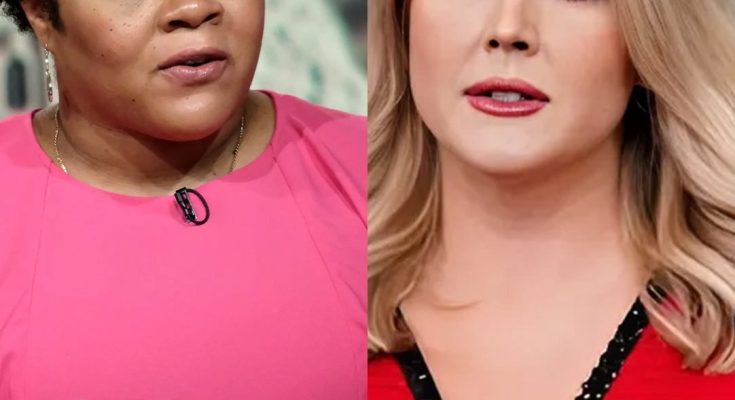A routine press briefing at the White House escalated into one of the most significant media events of the year as Press Secretary Karoline Leavitt engaged in a heated confrontation with NBC journalist Yamiche Alcindor—an interaction that is now being analyzed, clipped, and circulated widely on the internet.
What started as a pointed inquiry rapidly transformed into a public dismantling that rendered the press corps speechless, left the network in disarray, and placed Alcindor at the heart of an expanding internal investigation.
The controversy ignited when the conversation turned to a recent meeting in the Oval Office between President Trump and South African President Cyril Ramaphosa. During this meeting, Trump allegedly showcased a montage of videos that suggested violence against white farmers in South Africa. Critics swiftly raised concerns about the accuracy and motives behind the footage, branding it as “misleading” and “provocative.”
However, when the press sought clarification on the President’s choice to display such material, it was not Trump who responded—it was Karoline Leavitt.
Alcindor, recognized for her incisive questioning, stepped forward and directly asked, “What the president showed wasn’t true… That wasn’t a burial site. So I wonder—why did the president choose to lie?”
The question, direct and charged with emotion, altered the room’s atmosphere. The journalists present became still, and all attention shifted to Leavitt.
Without elevating her voice or losing her poise, Leavitt countered with a straightforward yet precise response: “What’s not true?”
Alcindor reiterated her challenge, accusing the administration of utilizing footage that did not accurately represent what it claimed. Yet, Leavitt maintained her position.
“It showed crosses,” she asserted firmly. “Crosses marking deaths. Real people. Real farmers—murdered and politically targeted because of their skin color.”
Control, Composure, and the Collapse of a Narrative
What ensued was less a dialogue and more a unilateral deconstruction. As Alcindor attempted to continue, her tone escalating, Leavitt remained composed, her demeanor unwavering.
“You cannot alter the perception of what individuals witnessed,” Leavitt remarked. “Those visuals were not concocted. They embodied something profoundly genuine. Attempting to undermine them—simply because they do not align with your network’s narrative—disrespects the families who are still mourning.”
The atmosphere intensified as Alcindor, evidently disturbed, sought to regain her footing. However, her irritation was apparent. She began to speak over Leavitt, gesturing towards the rear of the room, seemingly signaling for assistance—but none arrived.
By the conclusion of the discussion, what had started as a journalist confronting the administration had transformed. It became a scenario where the journalist seemed to lose her grip—and the Press Secretary, at merely 27 years of age, exited having commanded the room.
Viral Fallout and a Media Meltdown
In mere moments, the clip circulated on social media. It spread across various platforms like wildfire: Twitter (now X), TikTok, YouTube. Trending hashtags emerged: #KarolineCrushedIt, #AlcindorUnraveled, #PressRoomClash. Comments flooded in, ranging from commendations for Leavitt’s composure to critiques of Alcindor’s demeanor.
“That was not a briefing. That was a dismantling,” one user commented.
“Alcindor entered with confidence. She departed feeling shaken,” another user noted.
What transformed this viral incident into a potential media crisis, however, unfolded later.
NBC’s Internal Review and Behind-the-Scenes Fallout
As per various sources within NBC, Alcindor’s conduct is currently under quiet evaluation by senior management. Although no formal disciplinary measures have been disclosed, internal communications reportedly convey “concerns regarding tone, decorum, and journalistic integrity.”
An executive, speaking on the condition of anonymity, remarked: “We anticipate challenging inquiries from our reporters, but we also expect professionalism. What transpired today did not exemplify our highest standards.”
Reports suggest that Alcindor has been requested to refrain from future White House assignments—at least for the time being—while the situation is reexamined.
Critics of the administration contend that the moment diverted attention from valid inquiries regarding the accuracy and ethical considerations of the video footage presented to the South African President. They assert that Leavitt’s rhetorical skill should not eclipse the necessity for transparency.
Conversely, supporters argue that it was the press—particularly Alcindor—that allowed emotion to supersede professionalism.
This may be the most contentious element of the exchange: determining where the boundary exists between holding those in power accountable and veering into personal accusation.
The Aftermath—and What’s Next
As the situation stabilizes, the political and media landscape is left to contemplate what transpired—and its implications for the future.
For Alcindor, the path forward may necessitate the restoration of credibility and trust within her own organization and among her audience. For NBC, this incident raises questions about how their journalists conduct themselves during high-pressure live events.
For Leavitt, this confrontation enhances her burgeoning reputation as a fiercely articulate and resolute spokesperson—someone who remains steadfast, even amidst the intensity of live cameras and a charged atmosphere.
One thing is certain: this was not merely a viral video. It represented a clash of narratives, ideologies, and egos—with tangible repercussions.
Moreover, if the online response serves as any indication, the repercussions have only just begun.



